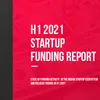From the investors’ lens: 7 factors that boosted funding growth in 2021 and the way forward
In 2021, Indian startups have so far raised a whopping $20 billion in funding, added 20 new unicorns, and saw two startups launch their IPOs (Zomato and Nazara). YourStory spoke to some top investors in the ecosystem to understand this capital inflow, and what lies ahead.
The 2021 Indian startup funding bonanza continues. This year, startups have, so far, raised almost $20 billion in funding, saw 20 new unicorns, and witnessed two IPOs — Zomato and Nazara. And it’s only August.
In July alone, the Indian startup ecosystem raised almost $10 billion (including a mega-round of $3.6 billion raised by Flipkart), and added three new unicorns to its cap. This is almost equal to the total funding raised in the first six months of 2021, and more than the entire amount raised in 2020.
This increase in capital inflow is largely due to growing investor confidence in a more mature Indian startup ecosystem with more seasoned returning entrepreneurs, amidst a rise in more global innovations and solutions being built.

With more and more startups leveraging the ‘pandemic induced opportunity’, investors are not shying away to take risks and invest large sums of money in Indian startups. This year has seen an increase in interest from global investors like Tiger Global and SoftBank.
According to Sanjay Mehta, Partner at 100X.VC, with India getting an amazing number of unicorns in H1, investment returns have soared for investors, revealed 100X.VC’s 2021 Sentiment Outlook research. This niche circle of investors got really big winners and have profited disproportionately, creating a flywheel effect, resulting in more investments in the early-stage startup ecosystem.
“This H1 funding has marked a historic high point for Indian investors,” he tells YourStory.
Rahul Chowdhri, Partner at Stellaris Venture Partners, adds that India has always held the promise of a large online user base, talent pool, and early-stage investor support.
“But what changed dramatically in the last 6-12 months is the fast pace of tech adoption in customer's life, recognition of the value that tech startups are creating by the public market, as well as low cost of capital globally coupled with limited alternate attractive geographies or asset class,” he says.

Here are 7 key factors boosting investor and founder confidence in 2021.
Rise of 2x/3x entrepreneurs
The Indian startup ecosystem has matured faster in the last few years, particularly due to the emergence of startups founded by 2x/3x entrepreneurs.
During the pandemic, we have seen these entrepreneurs pivoting to new models as well as launching new startups with innovative models.
“These founders are already experienced and know how to scale-up and this is exactly the reason why the ticket-size for early-stage funding is getting larger,” says Anuj Golecha, Co-Founder at Venture Catalysts.
For example, Jupiter, started by fintech veteran Jitendra Gupta, raised funds even before its launch. There are plenty of examples of such founders exiting their existing scale-up companies and launching new startups.

Change in consumer mindset
As Alok Mittal, angel investor and Co-founder at Indifi Technologies and Plaksha University, explains — the pandemic accelerated the digitisation of many industries, particularly lending, education, finance, and healthcare. This is deepening the consumer internet markets in India, driving the funding momentum.
Further, the lockdowns have pushed even Gen X consumers to look for digital options. Be it payments, medicines, consultations, or even ordering groceries — even consumers in Tier II and III areas are looking for online alternatives to solve for their daily needs.
Deeper digital inclusion across businesses
From traditional legacy businesses to SMBs, student entrepreneurs to corporates, everyone has one common agenda — get the right tech stack integrated at the right place at the right time. This also brings scalability, thereby making future collaborations easier and less expensive.
Manish Singhal, Founding Partner at Pi Ventures, said, “The pandemic provided a massive push to startups involved in improving automation and digital environments, fuelling funding into these companies. Also, Indian companies, especially backed with differentiating tech, are able to solve global problems with ease. That opens up the funding channels from across the globe.”

Global talent at the door
If vision is important for setting the direction, a good team is a must for reaching the destination. Except for a few industries that operate purely on physical labour, making the employees' presence compulsory in the office, the pandemic opened up opportunities for many to reach out and grab talent across the world.
For instance, Indian enterprise tech companies have been hiring experts in blockchain, data analytics, AI, IoT, and more, from the US, the UK, Israel, Egypt, and other areas.
Greater networking opportunities
Lockdowns haven’t stopped networking at all. In fact, the pandemic saw the rise of digital networking platforms like Clubhouse, Lunchclub, TapChief, CoffeMug.ai, among others. Events, too, shifted online, allowing attendees from across the globe to converge and network with like-minded individuals.
These changes made it easier for entrepreneurs to network with investors; the process became less time-consuming and cheaper.
Push towards global scalability and exit model
Growth and late-stage companies are now looking to build globally scalable products. Several companies have been exploring markets like the US, the UK, Israel, Abu Dhabi, and many Middle Eastern countries to extend their client network.
Further, late-stage companies are now looking for IPOs, signalling good exit opportunities for investors. Options like special purpose acquisition companies (SPACs) are further investors' attractive exit routes.
Alok Mittal said, “The pandemic has created a fresh cycle of liquidity injection globally, and hence, there are large pools of capital trying to find productive opportunities. This clearly seems to be driving the public market activity, which is fuelling private market activity to an extent where most VCs are now doing "angel" stage deals with relatively broad-based funnels.”
More avenues of funding
Sajith Pai, Director, Blume Ventures, emphasises that due to the maturity gained by the Indian startup ecosystem, a lot more money is coming in from family offices, entrepreneurs, and entrepreneurs themselves, who have done well. Some of this money is being used to fund early-stage startups, or even mid to late stages.
“Also, we are fundamentally in an easy money regime led by quantitative easing, the need to boost the economy — led primarily by the US. Structurally, a lot of money is getting into the stock market, into financial assets, and some of it is also finding its way into private markets,” he adds.

The way forward
Rahul of Stellaris highlights that the pandemic has changed customer behaviours dramatically across the board — from the rise of remote work, use of live video, AI penetrating our lives to a rise in the passion/creator economy, tech adoption by SMBs, move towards online entertainment/ education/health/finance, cross border commerce, and more.
“Founders who understand and build solutions to capture these changes will continue to attract investments,” he adds.
From an overall investors point of view, the need for higher investment returns is also forcing a lot of US folks to invest in emerging markets, which explains why PE/VC in emerging markets is a big draw. Some of this money is finding its way into the Indian markets as well.
Going forward, more 2x/3x entrepreneurs are expected to come up with new ventures in the next two years. Also, the rapid rise of the domestic investor community is creating a robust ecosystem in the Tier II and III areas.
“These domestic investors have been infusing massive capital into the ecosystem for the last 3-4 years, compared to almost negligible amount earlier,” Anuj adds.
The way forward will certainly continue to be attractive and the money regime is expected to be easy for a long while.
“Unless that gets tight, we are not going to see any challenges. We are also starting to see a lot of the startups do well, and witnessing an IPO boom. So, money will continue to circulate in the Indian startup ecosystem as founders/CXOs plough back money. All of this is only good news for the startup founder going forward,” Sajith concludes.
Edited by Saheli Sen Gupta











